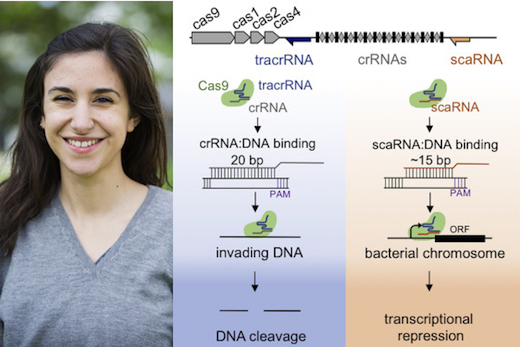In biotech these days, CRISPR/Cas9 is a hot topic, because of its utility as a precise gene editing tool. Before humans repurposed it, CRISPR/Cas9 was a sort of internal immune system bacteria use to defend themselves against phages, or viruses that infect bacteria, by slicing up the phages’ DNA.
Scientists at Emory University School of Medicine and the Max Planck Unit for the Science of Pathogens have found that the “scissors” component of CRISPR/Cas9 sometimes gets stuck. Cas9, an enzyme that cuts DNA, can also block gene activity without doing any cutting. In the pathogenic bacterium Francisella novicida, Cas9 regulates genes that need to be shut off for the bacteria to cause disease.
The results were published on June 27 in Molecular Cell.
Emory microbiologist David Weiss, PhD and colleagues had identified Cas9 several years ago when looking for genes that regulated F. novicida’s virulence. F. novicida is a close relative of the bacterium that causes tularemia, and it grows inside mammalian cells. For the current paper elucidating why Cas9 is important for virulence, his lab teamed up with researchers in Germany led by Emmanuelle Charpentier, PhD, whose work on CRISPR/Cas9 led to its use as a gene editing tool.
The researchers found that in F. novicida, Cas9 regulates just four genes, all of which must be turned off so that the bacteria can cause disease. In its DNA scissors/phage defense role, Cas9 is guided by an RNA that is complementary to the target. When Cas9 is acting to block gene activity, Cas9 uses a different RNA guide sequence, which doesn’t allow the scissors to cut because of its shorter length.
In other types of bacteria, Cas9 also appears to be important for the ability to cause disease.
“These findings raise the possibility that turning genes on and off may be a broad function of Cas9 in diverse bacteria,” says graduate student Hannah Ratner, the first author of the paper. “A question raised by this study is whether the ability of Cas9 to repress transcription can help explain the vast number of unidentified Cas9 targets.”
In addition, the researchers were able to re-engineer Cas9 to repress a new target, a gene that makes the bacteria resistant to a last-line antibiotic, re-sensitizing the bacteria to antibiotic treatment.
“The programmability of the same protein for multiple different functions highlights and expands the incredible versatility of Cas9 for genome engineering applications,” Ratner says.
Ratner is in the Microbiology and Molecular Genetics graduate program. Weiss is director of the Emory Antibiotic Resistance Center, and is part of the Emory Vaccine Center and based at Yerkes National Primate Research Center. The Emory research was supported by the National Institute of Allergy and Infectious Diseases (U54AI057157, R01AI110701) and the Burroughs Wellcome Fund.

